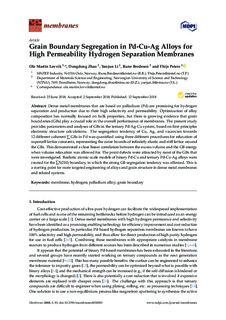| dc.contributor.author | Løvvik, Ole Martin | |
| dc.contributor.author | Zhao, Dongdong | |
| dc.contributor.author | Li, Yanjun | |
| dc.contributor.author | Bredesen, Rune | |
| dc.contributor.author | Peters, Thijs | |
| dc.date.accessioned | 2019-02-20T12:04:11Z | |
| dc.date.available | 2019-02-20T12:04:11Z | |
| dc.date.created | 2018-10-28T12:22:00Z | |
| dc.date.issued | 2018 | |
| dc.identifier.citation | Membranes. 2018, 8:81 (3), 1-17. | nb_NO |
| dc.identifier.issn | 2077-0375 | |
| dc.identifier.uri | http://hdl.handle.net/11250/2586521 | |
| dc.description.abstract | Dense metal membranes that are based on palladium (Pd) are promising for hydrogen separation and production due to their high selectivity and permeability. Optimization of alloy composition has normally focused on bulk properties, but there is growing evidence that grain boundaries (GBs) play a crucial role in the overall performance of membranes. The present study provides parameters and analyses of GBs in the ternary Pd-Ag-Cu system, based on first-principles electronic structure calculations. The segregation tendency of Cu, Ag, and vacancies towards 12 different coherent ∑ GBs in Pd was quantified using three different procedures for relaxation of supercell lattice constants, representing the outer bounds of infinitely elastic and stiff lattice around the GBs. This demonstrated a clear linear correlation between the excess volume and the GB energy when volume relaxation was allowed for. The point defects were attracted by most of the GBs that were investigated. Realistic atomic-scale models of binary Pd-Cu and ternary Pd-Cu-Ag alloys were created for the ∑ 5(210) boundary, in which the strong GB segregation tendency was affirmed. This is a starting point for more targeted engineering of alloys and grain structure in dense metal membranes and related systems. | nb_NO |
| dc.language.iso | eng | nb_NO |
| dc.publisher | MDPI | nb_NO |
| dc.rights | Navngivelse 4.0 Internasjonal | * |
| dc.rights.uri | http://creativecommons.org/licenses/by/4.0/deed.no | * |
| dc.title | Grain boundary segregation in Pd-Cu-Ag alloys for high permeability hydrogen separation membranes | nb_NO |
| dc.type | Journal article | nb_NO |
| dc.type | Peer reviewed | nb_NO |
| dc.description.version | publishedVersion | nb_NO |
| dc.source.pagenumber | 1-17 | nb_NO |
| dc.source.volume | 8:81 | nb_NO |
| dc.source.journal | Membranes | nb_NO |
| dc.source.issue | 3 | nb_NO |
| dc.identifier.doi | 10.3390/membranes8030081 | |
| dc.identifier.cristin | 1624203 | |
| dc.relation.project | Norges forskningsråd: nn2615k | nb_NO |
| dc.description.localcode | © 2018 by the authors. Licensee MDPI, Basel, Switzerland. This article is an open access article distributed under the terms and conditions of the Creative Commons Attribution (CC BY) license (http://creativecommons.org/licenses/by/4.0/). | nb_NO |
| cristin.unitcode | 194,66,35,0 | |
| cristin.unitname | Institutt for materialteknologi | |
| cristin.ispublished | true | |
| cristin.fulltext | original | |
| cristin.qualitycode | 1 | |

